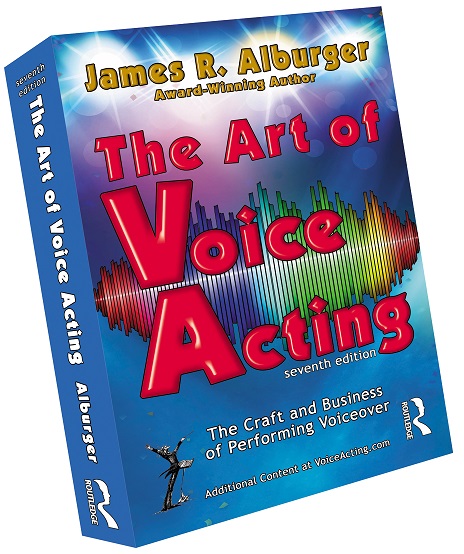|
VOICE ACTING
Note: This article is excerpted with permission from Chapter 5 of The Art of Voice Acting, Seventh Edition, by James Alburger. It’s all about having a conversation! Perhaps the single most requested direction is “make it conversational.” The request is nothing new. A conversational delivery has been a key part of voice acting for decades, and it’s an absolute necessity in most genres of voiceover. But exactly how do you do that? We have conversations every day with lots of people, and we never think about how we do it. We simply say what’s on our mind in a way that perfectly relates to the situation and the person we’re talking to. That works great in real life, but when you are working from a script where the words are not yours, the message is not yours, and the intention is not yours, everything changes. This chapter, and in fact a large part of this book, is about giving you the tools to help you effectively communicate the message in the script in a manner that the listener can relate to, understand and act upon. In most cases, that means having a conversation with that listener. Specific techniques for speaking conversationally are covered in Chapter 9, “The Conversation.” The concepts in this and the next few chapters will lay a foundation upon which you can build acting and performing skills that will allow you to almost effortlessly communicate a message in a script. Notice the words effective performance in this chapter’s title. To be effective, an actor must create a sense of drama or reality. Merriam-Webster defines drama as “a situation or series of events in which there is an interesting or intense conflict of forces.” In other words, drama gives a performance the appearance of reality through elements of conflict, humor, mystery, emotion, and feelings. Drama creates tension, suspense, and anticipation. As you learn how to apply the concepts in this book, and more specifically, in this chapter, you will begin to learn how to create compelling, believable, real, dramatic characters in the mind of your audience. You will also begin to understand how to speak the words of those characters conversationally, as if they are simply talking to someone. That’s what an effective performance is all about. In order to create drama, and thus an effective performance, “You must make choices and you must commit to those choices.” CREATING ILLUSION OF REALITY A voiceover performer is an actor - period. It doesn’t matter what the script is for, if it is well written or poorly written or if you are delivering the copy alone or with others. You are an actor when you stand in front of the microphone. And for all acting, pretending is where it starts. Regardless of the copy you are reading, there will always be some sort of character in the words. To be believable, that character must be brought to life. To do that effectively, you must re-learn how to play and become a master of pretending. By definition, the word pretend means “to give a false appearance of being.” So, if you are strictly pretending, you are not being real, but the objective of all acting is to create the illusion of reality. Learning how to pretend believably (or act) allows you overcome this apparent contradiction so you can step outside of yourself, using what you know as you move down the path of creating that illusion of reality. MAKING THE SCRIPT REAL The major problem most people have in performing for voiceover is that of creating a believable illusion of reality while reading from a script. Reading is a left-brain, linear process, while performing is a right-brain, nonlinear process. The tendency is to “read” the words rather than allowing the words to become real by believably pretending to be the person speaking the words. In theatrical and on-camera acting there is an invisible separation between the actor and the audience known as the fourth wall. The audience can see through this wall to experience the story, but the actors live in a world of their own. As voice actors, we are almost always telling our stories in the real world. We need to break down that fourth wall to have the conversation with our audience. SEVEN CORE ELEMENTS This is where the Seven Core Elements of an Effective Performance come in. By applying these seven elements, you can take your acting from simple pretending to creating a completely believable illusion of reality, thus breaking down that fourth wall. The Seven Core Elements are:
These techniques do not have to be done in sequence. In fact, most of the time one element will define another. As you work on your performance, start making choices in whichever element seems to be a good place to begin, but be sure that you include them all. FOR EXAMPLE: 1. AUDIENCE When you have a conversation with someone, you know who you are talking to. As a result, you naturally speak conversationally and in a manner that is appropriate for your topic of conversation. When working from a script, everything you need to know about who your character is speaking to is in the words. If you’re not clear on who you are talking to, make it up. By knowing your audience, you will be able to have a believable conversation, effectively breaking the fourth wall. The most important thing to remember is you are always talking to only one person. Attempting to shotgun your performance, by trying to connect with many people at once, will generally result in the listening audience losing interest or becoming uncomfortable. For the following line of copy, make some choices as to who the one, ideal person who needs to hear the message might be: Some people think they’re a mistake! But most people think they’re delicious! OK … so they’ve got a big seed and they’re green … Avocados! They’re still my favorite fruit. Great in salads … or all by themselves. Get some today. Here are some possible choices:
The choice you make for your audience will help determine your tone of voice, attitude, and overall approach to your performance. Focus your attention on speaking to just one person as though you were having a conversation with them. Describe the person you are speaking to in as much detail as possible and give him or her a name. Use a photograph to get the feeling of having eye contact with a real person. Doing this may help make your delivery more conversational and believable. Your one-person audience should be someone you do NOT know. When you select someone you know as your audience, the speaker of the words becomes you and your personal relationship with that individual will color your interpretation and delivery, making it considerably more challenging to create a believable performance. At some point you may determine that your choice of an audience is wrong. If or when this happens, simply change your choice and adjust your delivery accordingly. Email: jralburger@gmail.com |
Tell Us What YOU Think!
Please Note: Since we check for spam, there will be a slight delay in the actual posting of your comment.
Comments
No comments have been posted yet. Hurry, and you could be the first!
As of the NEW website launch, 03/22/2012

 By James Alburger
By James Alburger ABOUT JAMES
ABOUT JAMES





.png)


click for new article alerts